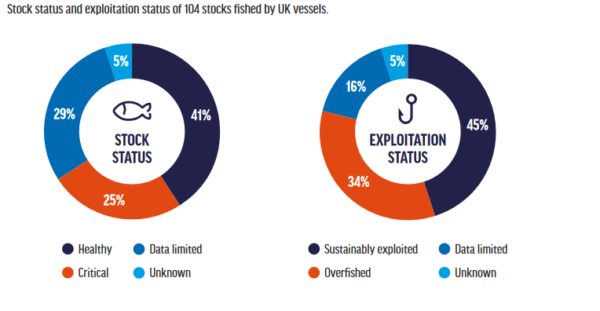A report from conservation charity Oceania considers the top five best (sustainably fished and healthy size) and worst (overfished and low size) performing stocks. Compared to the 2020 baseline, four of the five worst performing still have critically low stock sizes and are being overfished. Three of these five worst performing stocks are in such a state of crisis that a total ban on all catches is advised by the International Council for the Exploration of the Sea (ICES). These stocks are Celtic Sea cod, West of Scotland cod and Irish Sea whiting. The five best performing stocks are typically caught in comparatively small quantities and are of relatively low economic value.
As well as fishing pressure, the analysis assessed stock size, revealing that less than half (41%) are deemed to be of a healthy size and a quarter (25%) are in a critical condition. The health of the remaining stocks could not be determined due to lack of data, leaving them at greater risk of overfishing.
Credit: Figure 4 from Oceana report
The ongoing political decision to set Total Allowable Catches (TACs) higher than scientifically advised continues to lead to overfishing of North East Atlantic stocks. Comparing changes between the baseline and today, for instance, shows that six stocks that were a healthy size in 2020 have now declined to a critical state, and only three stocks have moved from being critically low to healthy since 2020.
This report confirms that sustainable catch limits lead to healthier fish stocks. For instance, for the five best performing stocks, TACs for 2020-2023 were mainly set in line with ICES scientific advice. However, for four of the five worst performing stocks, TACs were set higher than scientific advice for sustainability.
The main recommendations are that the UK should:
- Set catch limits that do not exceed the scientific advice of ICES. Ideally, these catches should remain well below this upper limit to account for wider ecosystem, climate change, discard and bycatch issues.
- Develop a clear and ambitious strategy to end overfishing, deliver sustainable fisheries for future generations, and meet the precautionary objective, as well as providing a timeframe to achieve it.
- Fully implement the fisheries act fisheries objectives, including ensuring that all Fisheries Management Plans contain clear measures, targets and a timeframe to achieve the Fisheries Act objectives.
- Ensure that fishing opportunities for mixed fisheries are consistent with sustainable exploitation of the most depleted stocks.
- Ensure a high standard of sustainability, transparency and legality of fisheries is met when granting reciprocal access to waters and resources.
- Phase out non-selective, carbon intensive and destructive fishing practices (especially bottom-towed fishing gear) in all marine protected areas and an inshore zone within three nautical miles of the coast.
To read the full article click here.
The executive summary of the Oceana report is available here and the full report can be downloaded here.
